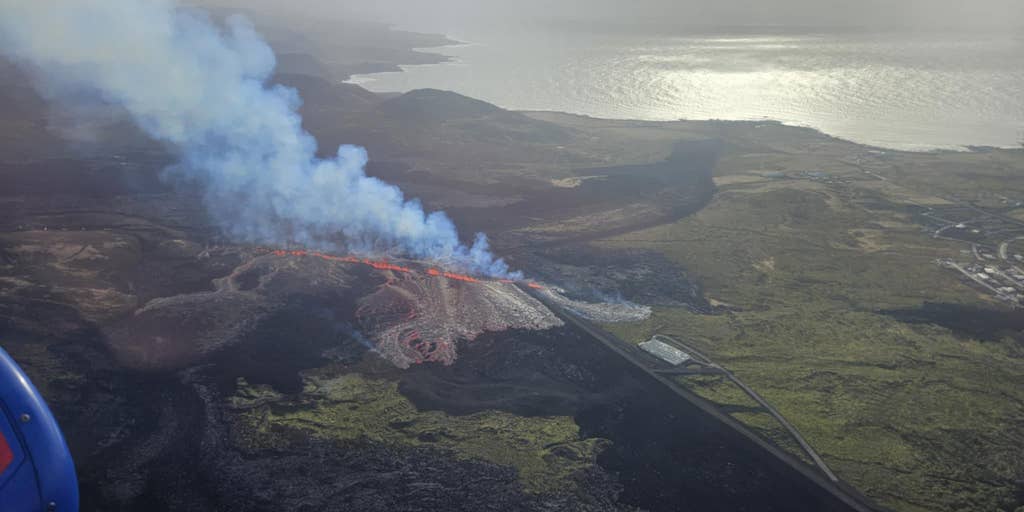A dramatic volcanic eruption in Iceland has forced the evacuation of thousands, including the popular Blue Lagoon geothermal spa and the nearby town of Grindavik. The eruption, which began on Tuesday, has seen lava breaching defensive walls, posing a significant threat to the area. This is a developing story, and FYM News is committed to providing you with the latest updates as the situation unfolds. The safety of residents and tourists is paramount, and the Icelandic authorities are working diligently to manage the crisis.
This eruption underscores the volatile geological landscape of Iceland, a country known for its active volcanoes and geothermal activity. The event highlights the importance of preparedness and monitoring in regions prone to natural disasters. Stay with us as we delve into the details of the eruption, the evacuation efforts, and the potential impact on the surrounding environment.
Iceland Volcano Eruption: A Close Look at the Reykjanes Peninsula
The eruption is occurring on the Reykjanes Peninsula, an area known for its high concentration of volcanic activity. According to the Icelandic Meteorological Office (IMO), the fissure where the lava is emerging is nearly a half-mile long. Photos and videos from the scene show lava flows dangerously close to Grindavik, prompting immediate evacuation orders. The IMO continues to monitor seismic activity in the region.
The proximity of the eruption to populated areas and tourist destinations has raised concerns about potential damage and disruption. Authorities are closely monitoring the lava flow and taking measures to protect critical infrastructure. The eruption serves as a reminder of the powerful forces of nature and the need for constant vigilance.
Thousands Evacuated as Iceland Volcano Threatens Grindavik and Blue Lagoon
Thousands of residents and tourists have been evacuated from Grindavik and the Blue Lagoon in response to the volcanic eruption. The Icelandic Civil Protection Agency is operating at an emergency level, coordinating the evacuation and providing support to those affected. The Blue Lagoon, one of Iceland’s most popular tourist attractions, has temporarily closed its doors to ensure the safety of visitors and staff.
The evacuation process has been carried out efficiently, with authorities prioritizing the safety and well-being of everyone in the affected areas. Emergency shelters have been set up to provide temporary accommodation and assistance to those who have been displaced. The focus remains on ensuring the safety of all individuals and minimizing any potential harm.
Blue Lagoon Temporarily Closes Due to Magma Intrusion
The Blue Lagoon geothermal spa, a world-renowned tourist destination, has announced a temporary closure due to the ongoing volcanic activity and magma intrusion. The decision was made to prioritize the safety of guests and employees. The closure will remain in effect until further notice, as authorities assess the situation and determine when it is safe to reopen.
The Blue Lagoon is a significant contributor to Iceland’s tourism industry, and its closure will undoubtedly have an impact on the local economy. However, the safety of visitors and staff is of paramount importance, and the decision to close was made with the best interests of everyone in mind. Updates on the reopening of the Blue Lagoon will be provided as they become available.
Icelandic Meteorological Office Records Volcanic Activity
The Icelandic Meteorological Office (IMO) is closely monitoring the volcanic activity and providing regular updates on the situation. According to the IMO, the lava has breached part of the defensive wall north of Grindavik. Seismic activity continues to be recorded in the surrounding areas, indicating the potential for further eruptions or changes in the lava flow.
The IMO plays a crucial role in providing timely and accurate information to the public and authorities, enabling them to make informed decisions and take appropriate action. The ongoing monitoring efforts are essential for understanding the dynamics of the eruption and mitigating any potential risks.
Iceland Volcano’s Recent History
The most recent volcanic eruption prior to this event occurred on Dec. 8, 2024. Iceland is no stranger to volcanic activity, with a history of eruptions shaping its landscape and impacting its communities. The country’s geological activity is a result of its location on the Mid-Atlantic Ridge, a boundary between two of the Earth’s major tectonic plates.
Iceland has developed sophisticated monitoring and emergency response systems to manage the risks associated with volcanic eruptions. These systems play a vital role in protecting lives and minimizing the impact of these natural events.
Grindavik: A Town Near the Eruption
Grindavik is a town located approximately 30 miles south of Iceland’s capital, Reykjavík. The town has been significantly impacted by the volcanic eruption, with residents forced to evacuate their homes. The community is now facing the challenges of displacement and uncertainty as they await updates on the situation.
The people of Grindavik have demonstrated resilience and community spirit in the face of adversity. Support and assistance are being provided to those who have been affected, and efforts are underway to help them rebuild their lives.
Key Takeaways from Iceland’s Volcanic Eruption
The volcanic eruption in Iceland serves as a reminder of the power of nature and the importance of preparedness. The swift evacuation of Grindavik and the Blue Lagoon highlights the effectiveness of Iceland’s emergency response systems. The ongoing monitoring efforts by the Icelandic Meteorological Office are crucial for understanding the dynamics of the eruption and mitigating any potential risks.
As the situation continues to unfold, FYM News will provide you with the latest updates and insights. Stay informed and stay safe.

Leave a Reply